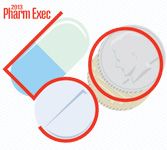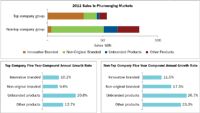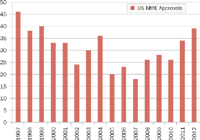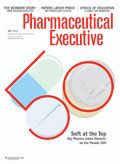2013 Pharm Exec Top 50
Patent expiries dampen revenues for some of the biggest Big Pharma, but growth continues unabated for a few nimble "stealth" players moving steadily up the list.
Disruptive market change in the biopharmaceutical industry is a given—but individual company performance is rising to the occasion through efficient deployment of a still considerable inventory of product, process, and knowledge assets. If anything, uncertainty has helped push the Big Pharma players to put their own houses in order, chiefly by slowing the hemorrhage in R&D costs, which has deflected the negatives from the transformation of healthcare as a budget buster—for both households and governments. True to form, Pharm Exec's 2013 ranking of the top 50 pharma companies worldwide finds few variations from last year, with the notable exception being the Rx success of global generic firms as they benefit from innovative portfolio diversification: Teva is nipping at the heels of Eli Lilly, at just one slot short of the top 10, while Ranbaxy joins the Pharma 50 list for the first time. Overall, however, only a relatively small set of companies—BMS, in particular, which drops to 17th in global Rx sales, from 11th last year—have been affected by the rush of patent expiries, contributing disproportionately to the weaker industry sales performance over the past several years.

Another enduring truth is the startling lack of concentrated market power in pharmaceuticals. What has not changed since we began compiling the Pharma 50 in 2000 is the top 10 still comprise less than 50 percent of the global market (their 2012 global share is 42 percent, compared to 43 percent in 2007). Other industries less reputationally vulnerable than pharma see much more concentration at the top; certainly this is true in the payer community, where governments increasingly hold sway. Even in the patent protected market, the core competency of Big Pharma, the top 10 players' share remained at 52 percent in 2012, the same level it was in 2007. The bottom line? For pharma, business is still an intensely competitive game of chance. —William Looney, Editor-in-Chief
To identify what's driving the numbers, we examined the top 50 as a group and in comparison to companies outside the top 50. We see five trends shaping current sales performance across the geographies where the pharma group competes:
Perhaps most notable is the contraction in the US market—the first in more than 50 years. This contraction comes not only from several patent expiries of billion dollar blockbusters—including Plavix, Seroquel, Lipitor, and Zyprexa—but also from increased scrutiny by payers for reimbursement and regulators for approval. The negative growth is driven by a few companies, each of whom had exposure to over $5 billion in revenue loss due to patent expiration of their major products. In the United States, there were 13 such companies in the five year period of 2008 to 2012: Pfizer, GSK, Takeda, Merck, J&J, BMS, AZ, Novartis, Sanofi, Lilly, Forest, Boehringer-Ingelheim, Eisai, and Roche. Thus, in Figure 1, we see that year-on-year growth for the entire market was negative for the first time.

Figure 1: Performance of US pharma market by company type.
For the 13 companies, year-on-year performance for 2012 amounted to a close to 10 percent contraction in revenues against 2011. Excluding these companies, we see that US growth performance for the remainder of the top 50 was actually slightly higher compared to last year. The 13 companies thus represent the brunt of the loss to the industry, with the remaining companies in the top 50 performing fairly well. The top line in Figure 1 represents the growth of all other companies with revenue in the United States, comprised of over 600 companies outside of the top 50. The growth in these companies is significantly more than the top 50, and includes companies with extremely varied portfolios, including branded products and generics. In many ways it is not surprising to see such growth, given that they are starting from a smaller base of revenues than the top 50 and that some are posting new revenues from newly launched generics, at the expense of those facing patent expiries.
The second trend is the impact of the recession in Europe, where we see a zero growth situation rather than an outright contraction. The lagging performance of the pharmaceutical industry in the five major EU countries is due more to austerity and government fiscal issues rather than inherent company dynamics. In these countries, patent expiration does not have as striking an effect on company sales after loss of exclusivity (LOE) because the branded product's retention of sales is much higher compared to the United States. Many companies retain significant sales from off-patent products in the EU five as government reimbursement treats off-patent brands and generics similarly. Nonetheless, policy changes in the last five years have changed this pattern substantially and there is significant reduction in sales for off-patent brands as well as steeper erosion of new patent expiries.
In the European countries, industry performance is thus a bit better than in the United States, with sales relatively flat and zero growth. Once again, a handful of countries are driving stagnant growth of the industry overall. In this case, by splitting the performance of the companies that had over $5 billion in patent exposure in the European Union alone—Novartis, Pfizer, Sanofi, Merck, GSK, AZ, and Takeda—we see that as a group these seven contracted by about almost 6 percent in 2012 (Figure 2). The remaining companies in the top 50 actually had an uptick in growth compared to 2011 with almost 3.5 percent growth in 2012, which is also stronger than the growth experienced by all the other companies with sales in Europe outside of the top 50. These remaining companies constitute about 1,600 small companies spread through all of the EU five markets.

Figure 2: Performance of EU pharma market by company type.
Third, in the other lead mature market, Japan, we see more positive growth for the industry, albeit at low single digits. The every-other-year mandatory price cuts on pharmaceutical products imposed by the government, defines the zig-zag nature of Figure 3. We can see, though, that by separating the performance of those five companies that had patent expiry revenue exposure close to $5 billion—Pfizer, Merck, Sanofi, Dainippon Sumitomo, and Eisai—performance of the other members of the top 50 was slightly higher than the group as a whole. Once again, performance of companies outside of the top 50 was even higher given the small base for growth.

Figure 3: Performance of Japan’s pharma market by company type.
The relatively higher growth in Japan for these five against their global norm was attributable in part to better performance of new launches and to the lower price cuts applied to protected brands under Japan's current NHS price control system. The Japanese government imposes a 5 to 6 percent price cut every other year, in April. In 2010, a revised policy provided lower price cuts for protected branded products, and steeper cuts for off-patent products and generics, amplifying the impact of more recent patent expiries and providing a boost to innovative companies, many of whom are responding by launching products in Japan earlier in their global launch sequence than they had in the past. Vaccines are another bright spot, aided by more government support for immunization and access.
Fourth, the strong economic growth platform provided by the emerging country markets are helping to differentiate revenues for those companies with a solid commitment to establishing a local presence (Figure 4). Not all the top 50 are playing in the emerging markets; the sales performance of those who are competing in these markets has been in the double-digits. Many of the top 50 are selling both original and branded generic products since growth in both of these sectors has been exceptionally strong in the past five years. However, despite the promise of continued double digit sales growth in many emerging markets, the gains have not been able to offset weaker performance in the United States and Europe.

Figure 4: The performance of the companies within the top 50 compared with performance of all the other companies selling in emerging markets.
In Figure 4, we see the performance of the companies within the top 50 compared with performance of all the other companies selling in emerging markets. The top 50 companies primarily are selling innovative brands along with branded generics and annual growth in these two segments has been close to 10 percent over the past five years. Companies outside of the top 50 are primarily selling branded generics (non-original brands that have some unique branding and where the company marketing the products is not the originator) and regular generics. The "other products" category includes OTC medicines as well as products like homeopathic or traditional Chinese medicines as well as vaccines. For companies outside of the top 50, the growth in all these segments has been incredibly strong, although the innovative brand growth is off a smaller base.
The fifth and final trend on performance of the Pharma 50 is the broad move away from relying on mergers, acquisitions, and divestitures to replace or supplement organic growth (Figure 5). The pace of mega-mergers since the start of the century has begun to slow—Pfizer/Pharmacia (2003), Sanofi/Aventis (2004), Roche/ Genentech (2009), Merck/Schering-Plough (2009), and Pfizer/Wyeth (2009). One might argue that Sanofi-Genzyme (in 2011) could be the last of the mega-mergers.

Figure 5: More new molecular entity drugs were approved in the United States last year than in any year since 1999.
Science dividend
Looking ahead, although industry performance in the mature market countries is slowing compared to historical rates, a trend moderated by the growing support from emerging markets, there is still a silver lining. More New Molecular Entity (NME) drugs were approved in the United States last year than in any year since 1999, continuing a rebound in approvals that started in 2011 and appears set to continue.

The right model?
The relative stability of the top 10 companies and the fact that many in this set have a predominant impact on the slow industry performance overall provides insight into the current discussion over alternative business models to drive future success. As companies look to fill the gaps in their portfolios by patent-expired blockbusters, most are finding that it takes several mid-sized products with appeal to a well-defined disease segment in the specialty class. This is because it is becoming increasingly difficult for drug makers in the small molecule, primary care markets to demonstrate the benefit of new drugs against the existing standard of care. A strength in specialist-driven markets provides better prospects up front, especially for those therapies that initiate use in the in-hospital setting. Regardless of whether it is a recent strategic choice, or if the company was one of the early few who began with a rationale to serve this segment, a visible presence in specialty seems to be working in the current environment.

Strategic choices aside, the extent and pace of future growth depends on a great number of factors including if and how those who pay for pharmaceuticals around the world make provisions to afford the wave of innovations that is coming from researchers' greater understanding of molecular biology and the genetic origins of disease. The signs of this rebound are there to see, so don't get too distracted by the industry-wide slowdown currently underway—this is one cycle that, like all others in the industry, will eventually play itself out.

Waseem Noor is a Vice-President with IMS Consulting Group and leads the global strategy and portfolio analysis team. He can be reached at wnoor@imscg.com. Michael Kleinrock is Director of Research Development at the IMS Institute for Healthcare Informatics. He can be reached at mkleinrock@us.imshealth.com.

Cell and Gene Therapy Check-in 2024
January 18th 2024Fran Gregory, VP of Emerging Therapies, Cardinal Health discusses her career, how both CAR-T therapies and personalization have been gaining momentum and what kind of progress we expect to see from them, some of the biggest hurdles facing their section of the industry, the importance of patient advocacy and so much more.
Applying Porter’s Five Forces to Portfolio Management in Pharmaceutical R&D: A Strategic Roadmap
March 17th 2025The increasing costs and complexity of R&D in the pharmaceutical industry have necessitated the adoption of strategic portfolio management to optimize resource allocation and enhance competitive advantage.